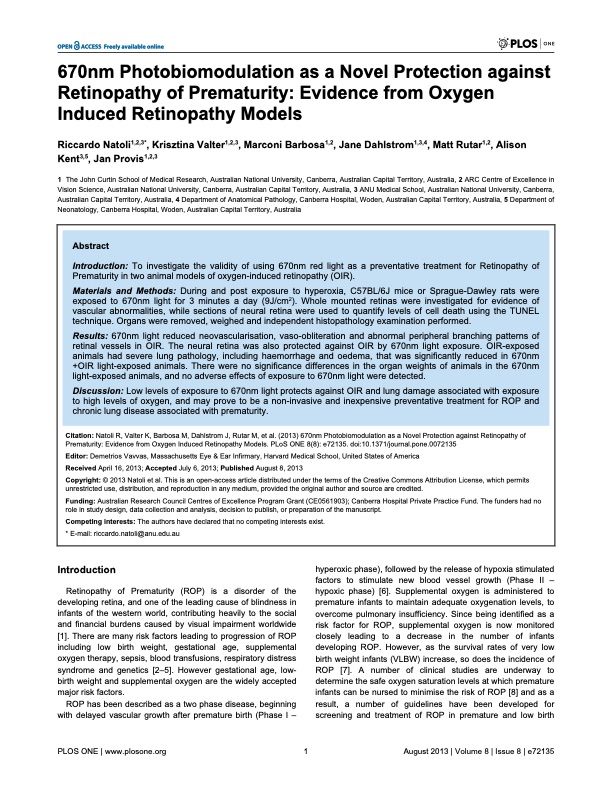
PDF Publication Title:
Text from PDF Page: 001
670nm Photobiomodulation as a Novel Protection against Retinopathy of Prematurity: Evidence from Oxygen Induced Retinopathy Models Riccardo Natoli1,2,3*, Krisztina Valter1,2,3, Marconi Barbosa1,2, Jane Dahlstrom1,3,4, Matt Rutar1,2, Alison Kent3,5, Jan Provis1,2,3 1 The John Curtin School of Medical Research, Australian National University, Canberra, Australian Capital Territory, Australia, 2 ARC Centre of Excellence in Vision Science, Australian National University, Canberra, Australian Capital Territory, Australia, 3 ANU Medical School, Australian National University, Canberra, Australian Capital Territory, Australia, 4 Department of Anatomical Pathology, Canberra Hospital, Woden, Australian Capital Territory, Australia, 5 Department of Neonatology, Canberra Hospital, Woden, Australian Capital Territory, Australia Abstract Introduction: To investigate the validity of using 670nm red light as a preventative treatment for Retinopathy of Prematurity in two animal models of oxygen-induced retinopathy (OIR). Materials and Methods: During and post exposure to hyperoxia, C57BL/6J mice or Sprague-Dawley rats were exposed to 670nm light for 3 minutes a day (9J/cm2). Whole mounted retinas were investigated for evidence of vascular abnormalities, while sections of neural retina were used to quantify levels of cell death using the TUNEL technique. Organs were removed, weighed and independent histopathology examination performed. Results: 670nm light reduced neovascularisation, vaso-obliteration and abnormal peripheral branching patterns of retinal vessels in OIR. The neural retina was also protected against OIR by 670nm light exposure. OIR-exposed animals had severe lung pathology, including haemorrhage and oedema, that was significantly reduced in 670nm +OIR light-exposed animals. There were no significance differences in the organ weights of animals in the 670nm light-exposed animals, and no adverse effects of exposure to 670nm light were detected. Discussion: Low levels of exposure to 670nm light protects against OIR and lung damage associated with exposure to high levels of oxygen, and may prove to be a non-invasive and inexpensive preventative treatment for ROP and chronic lung disease associated with prematurity. Citation: Natoli R, Valter K, Barbosa M, Dahlstrom J, Rutar M, et al. (2013) 670nm Photobiomodulation as a Novel Protection against Retinopathy of Prematurity: Evidence from Oxygen Induced Retinopathy Models. PLoS ONE 8(8): e72135. doi:10.1371/journal.pone.0072135 Editor: Demetrios Vavvas, Massachusetts Eye & Ear Infirmary, Harvard Medical School, United States of America Received April 16, 2013; Accepted July 6, 2013; Published August 8, 2013 Copyright: © 2013 Natoli et al. This is an open-access article distributed under the terms of the Creative Commons Attribution License, which permits unrestricted use, distribution, and reproduction in any medium, provided the original author and source are credited. Funding: Australian Research Council Centres of Excellence Program Grant (CE0561903); Canberra Hospital Private Practice Fund. The funders had no role in study design, data collection and analysis, decision to publish, or preparation of the manuscript. Competing interests: The authors have declared that no competing interests exist. * E-mail: riccardo.natoli@anu.edu.au Introduction Retinopathy of Prematurity (ROP) is a disorder of the developing retina, and one of the leading cause of blindness in infants of the western world, contributing heavily to the social and financial burdens caused by visual impairment worldwide [1]. There are many risk factors leading to progression of ROP including low birth weight, gestational age, supplemental oxygen therapy, sepsis, blood transfusions, respiratory distress syndrome and genetics [2–5]. However gestational age, low- birth weight and supplemental oxygen are the widely accepted major risk factors. ROP has been described as a two phase disease, beginning with delayed vascular growth after premature birth (Phase I – hyperoxic phase), followed by the release of hypoxia stimulated factors to stimulate new blood vessel growth (Phase II – hypoxic phase) [6]. Supplemental oxygen is administered to premature infants to maintain adequate oxygenation levels, to overcome pulmonary insufficiency. Since being identified as a risk factor for ROP, supplemental oxygen is now monitored closely leading to a decrease in the number of infants developing ROP. However, as the survival rates of very low birth weight infants (VLBW) increase, so does the incidence of ROP [7]. A number of clinical studies are underway to determine the safe oxygen saturation levels at which premature infants can be nursed to minimise the risk of ROP [8] and as a result, a number of guidelines have been developed for screening and treatment of ROP in premature and low birth PLOS ONE | www.plosone.org 1 August 2013 | Volume 8 | Issue 8 | e72135PDF Image | 670nm Photobiomodulation as a Novel Protection to Retinopathy

PDF Search Title:
670nm Photobiomodulation as a Novel Protection to RetinopathyOriginal File Name Searched:
05f0c1a1f2e8aec2744443e83bbeec817202.pdfDIY PDF Search: Google It | Yahoo | Bing
Cruise Ship Reviews | Luxury Resort | Jet | Yacht | and Travel Tech More Info
Cruising Review Topics and Articles More Info
Software based on Filemaker for the travel industry More Info
The Burgenstock Resort: Reviews on CruisingReview website... More Info
Resort Reviews: World Class resorts... More Info
The Riffelalp Resort: Reviews on CruisingReview website... More Info
| CONTACT TEL: 608-238-6001 Email: greg@cruisingreview.com | RSS | AMP |